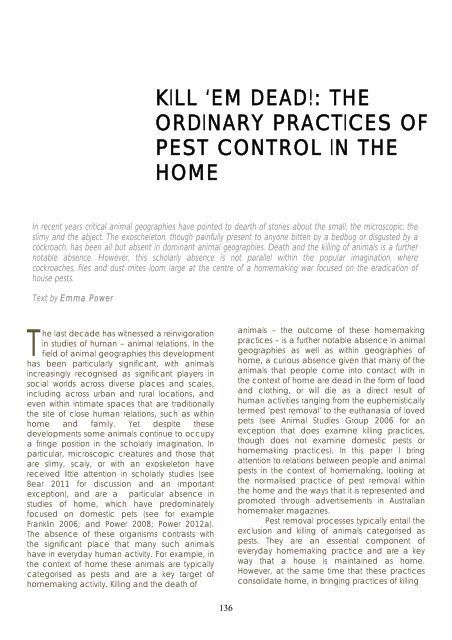Marketing Animals - Antennae The Journal of Nature in Visual Culture
Marketing Animals - Antennae The Journal of Nature in Visual Culture
Marketing Animals - Antennae The Journal of Nature in Visual Culture
Create successful ePaper yourself
Turn your PDF publications into a flip-book with our unique Google optimized e-Paper software.
T<br />
he last decade has witnessed a re<strong>in</strong>vigoration<br />
<strong>in</strong> studies <strong>of</strong> human – animal relations. In the<br />
field <strong>of</strong> animal geographies this development<br />
has been particularly significant, with animals<br />
<strong>in</strong>creas<strong>in</strong>gly recognised as significant players <strong>in</strong><br />
social worlds across diverse places and scales,<br />
<strong>in</strong>clud<strong>in</strong>g across urban and rural locations, and<br />
even with<strong>in</strong> <strong>in</strong>timate spaces that are traditionally<br />
the site <strong>of</strong> close human relations, such as with<strong>in</strong><br />
home and family. Yet despite these<br />
developments some animals cont<strong>in</strong>ue to occupy<br />
a fr<strong>in</strong>ge position <strong>in</strong> the scholarly imag<strong>in</strong>ation. In<br />
particular, microscopic creatures and those that<br />
are slimy, scaly, or with an exoskeleton have<br />
received little attention <strong>in</strong> scholarly studies (see<br />
Bear 2011 for discussion and an important<br />
exception), and are a particular absence <strong>in</strong><br />
studies <strong>of</strong> home, which have predom<strong>in</strong>ately<br />
focused on domestic pets (see for example<br />
Frankl<strong>in</strong> 2006; and Power 2008; Power 2012a).<br />
<strong>The</strong> absence <strong>of</strong> these organisms contrasts with<br />
the significant place that many such animals<br />
have <strong>in</strong> everyday human activity. For example, <strong>in</strong><br />
the context <strong>of</strong> home these animals are typically<br />
categorised as pests and are a key target <strong>of</strong><br />
homemak<strong>in</strong>g activity. Kill<strong>in</strong>g and the death <strong>of</strong><br />
KILL ‘EM DEAD!: THE<br />
ORDINARY PRACTICES OF<br />
PEST CONTROL IN THE<br />
HOME<br />
In recent years critical animal geographies have po<strong>in</strong>ted to dearth <strong>of</strong> stories about the small, the microscopic, the<br />
slimy and the abject. <strong>The</strong> exoscheleton, though pa<strong>in</strong>fully present to anyone bitten by a bedbug or disgusted by a<br />
cockroach, has been all but absent <strong>in</strong> dom<strong>in</strong>ant animal geographies. Death and the kill<strong>in</strong>g <strong>of</strong> animals is a further<br />
notable absence. However, this scholarly absence is not parallel with<strong>in</strong> the popular imag<strong>in</strong>ation, where<br />
cockroaches, files and dust mites loom large at the centre <strong>of</strong> a homemak<strong>in</strong>g war focused on the eradication <strong>of</strong><br />
house pests.<br />
Text by Emma Power<br />
136<br />
animals – the outcome <strong>of</strong> these homemak<strong>in</strong>g<br />
practices – is a further notable absence <strong>in</strong> animal<br />
geographies as well as with<strong>in</strong> geographies <strong>of</strong><br />
home, a curious absence given that many <strong>of</strong> the<br />
animals that people come <strong>in</strong>to contact with <strong>in</strong><br />
the context <strong>of</strong> home are dead <strong>in</strong> the form <strong>of</strong> food<br />
and cloth<strong>in</strong>g, or will die as a direct result <strong>of</strong><br />
human activities rang<strong>in</strong>g from the euphemistically<br />
termed ‘pest removal’ to the euthanasia <strong>of</strong> loved<br />
pets (see Animal Studies Group 2006 for an<br />
exception that does exam<strong>in</strong>e kill<strong>in</strong>g practices,<br />
though does not exam<strong>in</strong>e domestic pests or<br />
homemak<strong>in</strong>g practices). In this paper I br<strong>in</strong>g<br />
attention to relations between people and animal<br />
pests <strong>in</strong> the context <strong>of</strong> homemak<strong>in</strong>g, look<strong>in</strong>g at<br />
the normalised practice <strong>of</strong> pest removal with<strong>in</strong><br />
the home and the ways that it is represented and<br />
promoted through advertisements <strong>in</strong> Australian<br />
homemaker magaz<strong>in</strong>es.<br />
Pest removal processes typically entail the<br />
exclusion and kill<strong>in</strong>g <strong>of</strong> animals categorised as<br />
pests. <strong>The</strong>y are an essential component <strong>of</strong><br />
everyday homemak<strong>in</strong>g practice and are a key<br />
way that a house is ma<strong>in</strong>ta<strong>in</strong>ed as home.<br />
However, at the same time that these practices<br />
consolidate home, <strong>in</strong> br<strong>in</strong>g<strong>in</strong>g practices <strong>of</strong> kill<strong>in</strong>g












